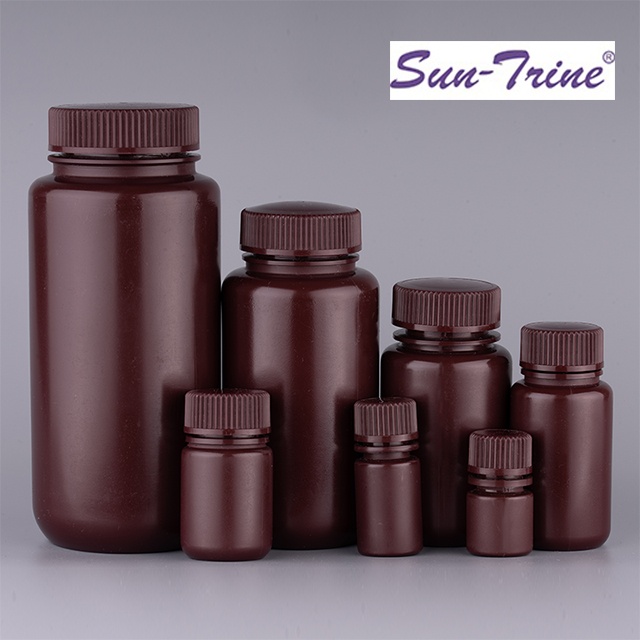Introduction
In the intricate world of laboratory procedures, the choice of glassware is a strategic decision that can impact the integrity and stability of stored chemicals. This is particularly true for 1000ml lab glass amber reagent bottles. In this exploration, we delve into the material composition of these bottles and how it plays a pivotal role in ensuring the safe storage and preservation of sensitive chemicals.

Material Composition of 1000ml Lab Glass Amber Reagent Bottle
At the heart of every 1000ml lab glass amber reagent bottle lies a carefully selected material composition. The primary component is high-quality glass known for its purity and inert properties. This glass is meticulously crafted to meet stringent quality standards, ensuring that it remains chemically resistant and inert, preserving the integrity of the stored chemicals.
In addition to the glass, certain 1000ml lab glass amber reagent bottles may have additional coatings or treatments to enhance their performance. These supplementary features are designed to complement the inherent properties of the glass and provide an extra layer of protection for the stored reagents.
Characteristics Ensuring Safe Storage
The material composition of 1000ml lab glass amber reagent bottles is characterized by several key attributes that contribute to safe storage. One of the paramount features is chemical resistance. The glass resists interactions with a wide range of chemicals, ensuring that the purity of the stored substances remains intact.
The inert properties of the glass are equally crucial. The material does not react with the chemicals it houses, preventing any contamination or alteration of the stored reagents. This non-reactive nature is fundamental in maintaining the accuracy and reliability of laboratory experiments and analyses.
Protection Against Light-Sensitive Chemicals
One of the distinctive features of 1000ml lab glass amber reagent bottles is their amber color. This color serves a dual purpose: it not only distinguishes these bottles aesthetically but also provides a critical layer of protection against light-sensitive chemicals.
The amber hue acts as a filter, selectively blocking out specific wavelengths of light. This filtration prevents photodegradation, a process in which light exposure induces chemical reactions in sensitive substances, compromising their stability. The material composition, coupled with the amber color, creates a formidable shield against the potentially detrimental effects of light.
Compliance with Industry Standards
The use of 1000ml lab glass amber reagent bottles aligns with industry standards for lab glassware. These standards ensure the quality, safety, and reliability of glassware used in laboratory settings. Certifications and regulatory compliance are paramount, offering assurance that the material composition meets or exceeds established benchmarks for safety and performance.
Features Distinguishing High-Quality Bottles
Beyond the general material composition, certain features distinguish high-quality 1000ml lab glass amber reagent bottles. Thickness and durability play a crucial role in the overall robustness of the bottle. Quality control measures in manufacturing ensure precision and consistency, guaranteeing that each bottle meets the specified standards.
Resistance to temperature variations is another hallmark of high-quality bottles. This feature ensures that the bottles can safely accommodate a diverse range of chemicals and can endure the demands of various laboratory environments.
Considerations for Specific Chemicals
The material composition of 1000ml lab glass amber reagent bottles is not one-size-fits-all. Different chemicals may have varying levels of reactivity or compatibility with the material. Therefore, considerations for specific chemicals are essential when selecting the appropriate bottle.
Guidelines exist to aid in the selection process, taking into account the potential impact of the material on the stored substances. Real-world examples highlight instances where the right bottle choice directly contributed to the stability and longevity of specific chemicals.
Cleaning and Maintenance Recommendations
Ensuring the longevity and continued safety of 1000ml lab glass amber reagent bottles involves proper cleaning and maintenance. Best practices for cleaning are designed to prevent cross-contamination and maintain the purity of the glass. Maintenance tips contribute to the bottles' extended lifespan and help preserve the integrity of the stored reagents.
Proper handling is emphasized, as mishandling can compromise the material composition and effectiveness of the bottles. A combination of meticulous cleaning and attentive maintenance fosters an environment conducive to the bottles' ongoing performance.
Industry Applications and Use Cases
The versatility of 1000ml lab glass amber reagent bottles finds expression in a myriad of laboratory applications. From pharmaceutical research to chemical analysis, these bottles serve as reliable vessels for a diverse range of substances. Real-world use cases exemplify the practical benefits of the material composition in specific research or industrial settings.
Success stories underscore the efficacy of 1000ml lab glass amber reagent bottles in preserving sensitive chemicals and contribute to the growing body of evidence supporting their suitability for various laboratory applications.
Supplier Transparency and Communication
The relationship between suppliers and customers is built on transparency and communication. Suppliers play a pivotal role in providing information about the material composition of 1000ml lab glass amber reagent bottles. This transparency empowers customers to make informed decisions, aligning their choices with the specific requirements of their work.
Customers are encouraged to seek information on the material used in the manufacturing process and inquire about certifications or adherence to industry standards. Supplier transparency not only builds trust but also ensures that customers are equipped with the knowledge necessary for making optimal purchasing decisions.
Conclusion
In conclusion, the material composition of 1000ml lab glass amber reagent bottles is a critical determinant of their efficacy in ensuring safe storage and preservation of sensitive chemicals. The glass, with its chemical resistance and inert properties, forms the backbone of these bottles, providing a secure environment for a myriad of laboratory applications.
The amber color, a visual distinction, serves a functional purpose by filtering out harmful light and safeguarding light-sensitive chemicals. High-quality features, adherence to industry standards, and considerations for specific chemicals further elevate these bottles as indispensable tools in laboratory settings.
As the industry continues to advance, awareness, education, and a commitment to supplier transparency will ensure that 1000ml lab glass amber reagent bottles remain at the forefront of safe and reliable chemical storage in laboratories worldwide.
Related Products





